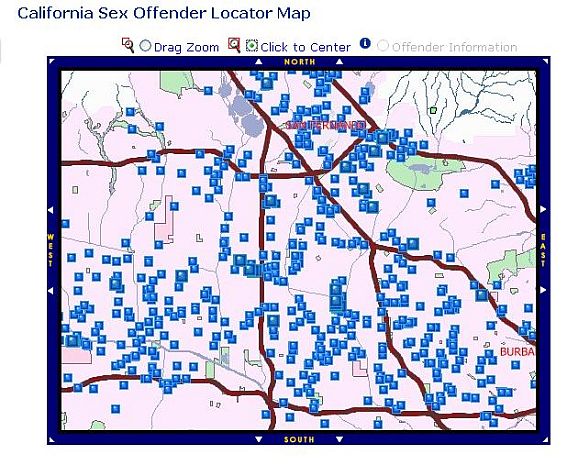SEARCH THE MEGAN'S LAW DATABASE

Click to search the state database for sex offenders living in your neighborhood |
|
LA gets more sex offenders
Restrictions also lead to rise in homelessness
by C.J. Lin
LA Daily News
October 5, 2010
Residency restrictions in neighboring cities have forced an influx of sex offenders into Los Angeles, where the difficulty in housing them has led to a spike in homeless parolees, police said Tuesday.
Of the 5,100 registered sex offenders living in Los Angeles, about 1,020 – or 20 percent – are on parole or probation and thus prohibited from living within 2,000 feet of schools or parks where children gather, LAPD Detective Diane Webb told the Police Commission.
Because this prohibition limits the neighborhoods where sex offenders can live, parole agents frequently place them in apartments or facilities that have been converted to house multiple sex offenders, Webb said.
Clustering sex offenders does not increase recidivism rates and research has shown there is no relationship between where they live and whether they are likely to reoffend, Webb said.
But one "unintended effect" of the residency restrictions of Jessica's Law is that the number of homeless parolees is increasing, which does boost the chance of them re-offending, Webb said. |
"If you're living under a bridge somewhere, you're not near your family support network, you're not near the services you need," said Webb, who heads a police team that monitors sex offenders.
The number of homeless sex offenders has soared from 191 in October 2007, when the city's residency restrictions took effect, to 576 last month, according to the LAPD's Registration Enforcement and Compliance Team (REACT).
Unlike other local cities, L.A. has no additional restrictions on where offenders can live. Long Beach, however, has restricted occupancy numbers in apartment buildings, forcing registrants to move. Other cities have considered designating greenbelts or beaches as parks, severely limiting the areas where offenders can live.
"I still think L.A. is doing the right thing in not pushing them out," said Webb, who added that REACT has not seen an increase in sex crimes. "They're really between a rock and a hard place."
Sober-living homes - unlicensed facilities that are limited to housing six sex offenders in residential neighborhoods - are slowly disappearing, while multi-unit apartment buildings, duplexes and residential hotel locations are more often being used by parole agents to house offenders, Webb said. In 2005, there were 67 such facilities housing 235 offenders in L.A. Currently, 25 homes are housing about 150 offenders, according to the report.
According to a list compiled by REACT, 23 sober living homes, apartments and motels remain in the Valley. One apartment in Van Nuys is home to 11 offenders, according to a state locator website.
"This problem is two-fold: Sex offenders are being released into society, and yet we don't have the tools we need to regulate where they end up living," said City Councilman Greig Smith, who chairs the council's Public Safety Committee and has been pushing for an ordinance to regulate unlicensed group homes in residential neighborhoods.
|